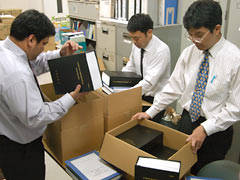Defense Bureau submits revised Environmental Impact Statement on the Futenma relocation

At around 4:20pm on December 18, at the Okinawa Prefectural Office, staff members of the Okinawa Prefectural Government took out the revised Environmental Impact Statement from boxes submitted by the Okinawa Defense Bureau.
December 19, 2012 Ryukyu Shimpo
On December 18, the Okinawa Defense Bureau submitted to the Okinawa Prefectural Government (OPG) the revised version of the Environmental Impact Statement (EIS) about the relocation of U.S. Marine Corps Air Station Futenma to Henoko in Nago. With this, the government has now completed the requirements of the assessment procedure. On December 19, after confirming that there were no deficiencies in the document, the OPG accepted the revised EIS. The government will now apply to the Governor of Okinawa for approval of the Henoko landfill. The Okinawa Defense Bureau will give public notice and provide access to the EIS at five locations including the OPG office, Nago and Ginoza municipal offices and the Bureau office. This will occur over a one-month period, starting at the end of the year. Referring to the Okinawa Defense Bureau having submitted the revision of the EIS immediately after the election and before the inauguration of the new government, Okinawa Governor Hirokazu Nakaima said to the press, “This is quite unexpected.”
Although the government is able to apply for approval of the landfill before the end of the period of public release and perusal of the revised EIS, an official of the Ministry of Defense commented that normally this happens after the period of public notice. With regard to the effect of aircraft noise, in the revised EIS, a WECPNL (Weighted Equivalent Continuous Perceived Noise Level) value of 71.3 was recorded at the fishing port at Henoko. This figure exceeds the environmental standard because the noise prediction survey now covers the engine noise adjustment and hovering of all aircraft, including the Osprey, something that was not included in the previous EIS. The WECPNL values were higher than those in the previous EIS in all 15 locations in which the survey was conducted.
With regard to dugong, a recognized Japanese national treasure, the Ministry of Defense carried out a population viability analysis and calculated the probability of extinction for the dugong in 100 years. The report concluded that the difference between the extent of the risk of extinction due to the initial population of females and its reproductive rate was relatively large, but that there was no difference in the risk of extinction before and after the project being conducted.
Compared to the extent of the risk of natural extinction for the three dugongs that the Ministry of Defense has confirmed as existing in the area, the government underestimated the negative impact on the dugongs that face of extinction due to the construction project for the alternative facilities for the Futenma Air Station.
According to the OPG, at around 3:30pm, on December 18, about 20 staff members of the Okinawa Defense Bureau carried the revised EIS documents in about 20 boxes into the relevant sections of the OPG such as the Environmental Policy Division and the Coastal and Disaster Prevention Division. About 30 minutes later, Defense Bureau staff also delivered the documents to the Nago and Ginoza municipal offices. The Governor of Okinawa has submitted a statement of opinion, in which he concluded that protection of the environment would be impossible, pointing out that based on the laws and regulations of the Okinawa Prefectural Government there were a total of 579 deficiencies in the EIS. The next step will focus on how many of the points that the Governor of Okinawa suggested in his statement of opinion have actually been achieved in the new EIS.
(English translation by T&CT, Mark Ealey)
Previous Article:OPG to set up sexual assault victim assistance center
Next Article:Donald Keene visits the Cornerstone of Peace in Itoman
[Similar Articles]
- Okinawa governor rejects environmental impact assessment report
- Henoko reclamation to cost 231 billion yen
- Okinawan governor submits opinion on the Futenma relocation plan, calling it “impossible”
- Japanese government sticks to Henoko relocation plan
- Government blocks Okinawa Governor’s revocation of Henoko landfill
 Webcam(Kokusai Street)
Webcam(Kokusai Street)


